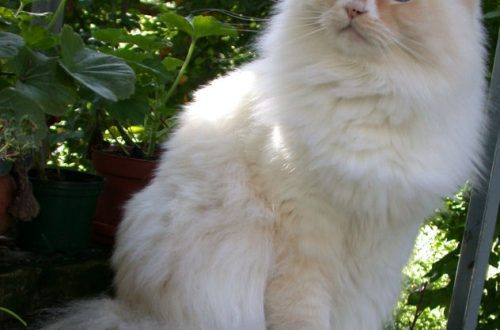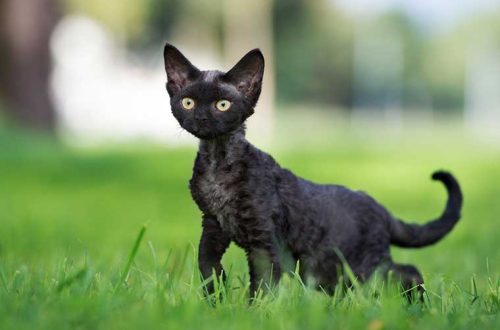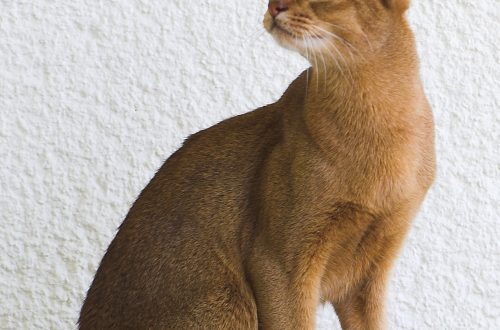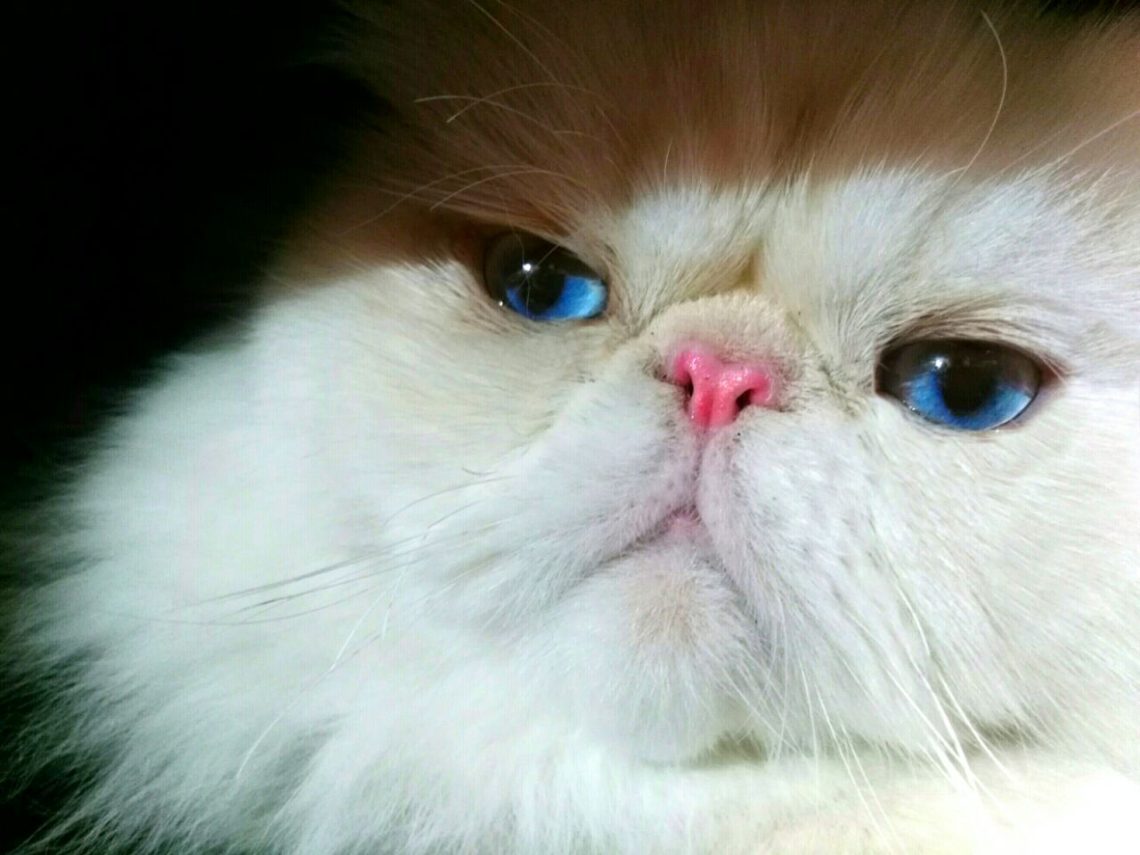
Himalayan cat
Other names: Persian color point
The Himalayan cat is a blue-eyed, long-haired, color-pointed creature, obtained by mating Persians with representatives of the Siamese group. Some felinological systems register representatives of this family as an independent breed, others as a variety of Persian cats.
Contents
Characteristics of Himalayan cat
| Country of origin | USA |
| Wool type | Longhair |
| Height | 25-30 cm |
| Weight | 4-6 kg |
| Age | up to 15 years |
Basic moments
- Due to their textured, memorable appearance, Himalayan cats successfully conquer the cinema Olympus. The most popular films with the participation of Persian-Siamese are Meet the Parents and Movie Date.
- The owners of the breed call its representatives Himalayans or Himalayas.
- In 2014, a Himalayan mestizo named Colonel Meow became the hero of memes because of the eternally dissatisfied expression of the muzzle, and also temporarily entered the Guinness Book of Records as the owner of the longest coat.
- The stylish image of the Persian-Siamese is entirely the result of the master’s diligence, since the long hair of the breed falls off easily, which means it needs regular care and combing.
- The peak of motor activity is observed in kittens. As they grow older, representatives of the breed behave sedately and passively, although they are not averse to driving their favorite toy.
- Himalayan cats are very reserved in terms of requests, so if you dream of a small and melodious cat, consider that you have found him.
- The breed does not like noisy events, so during a party, its representative will most likely hide in a remote room or under a table.
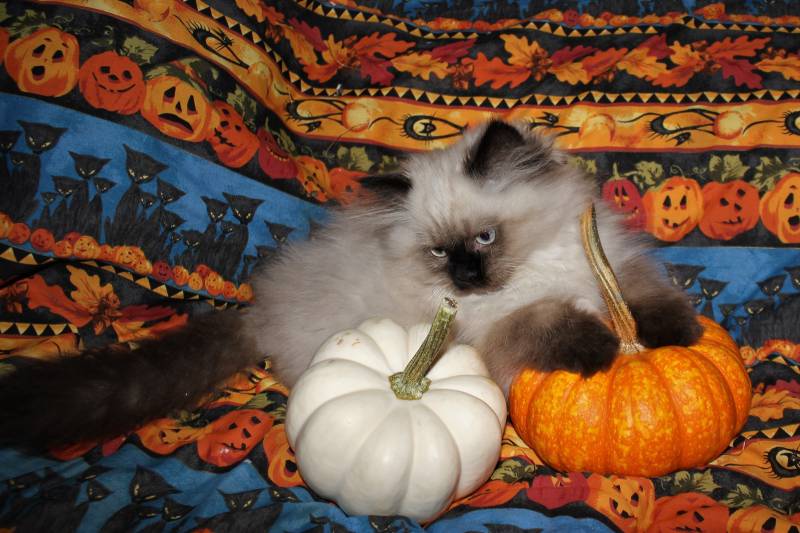
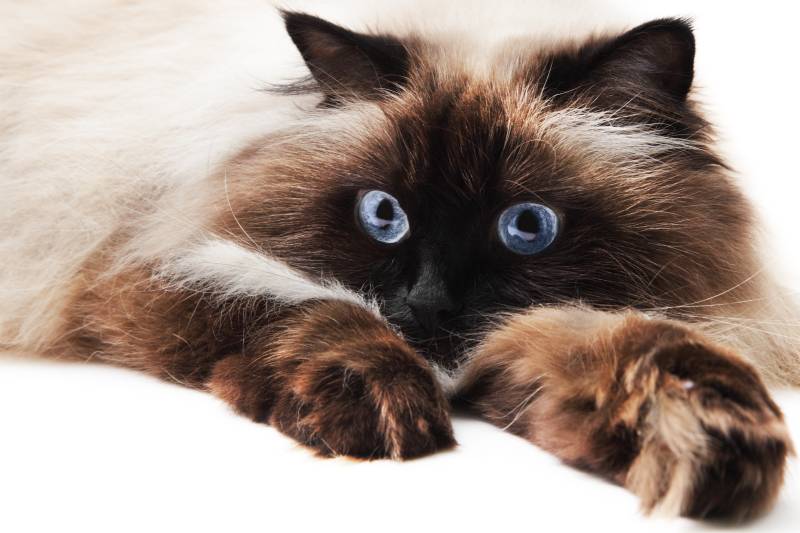
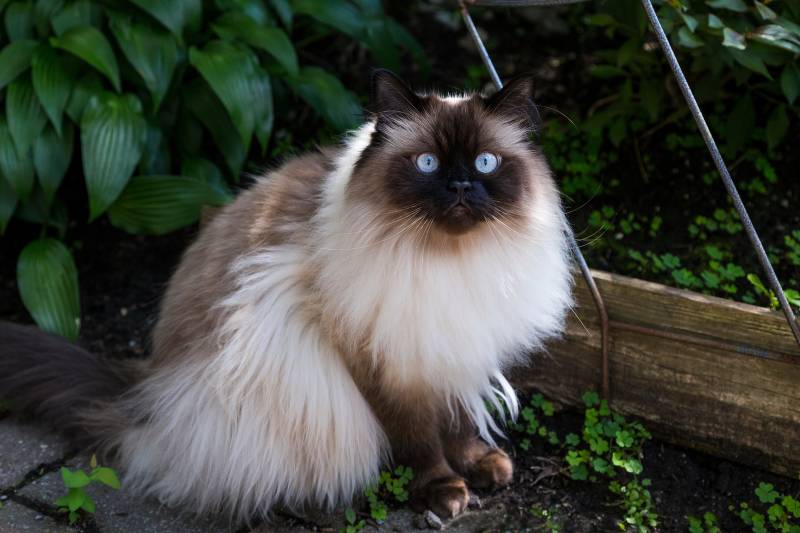
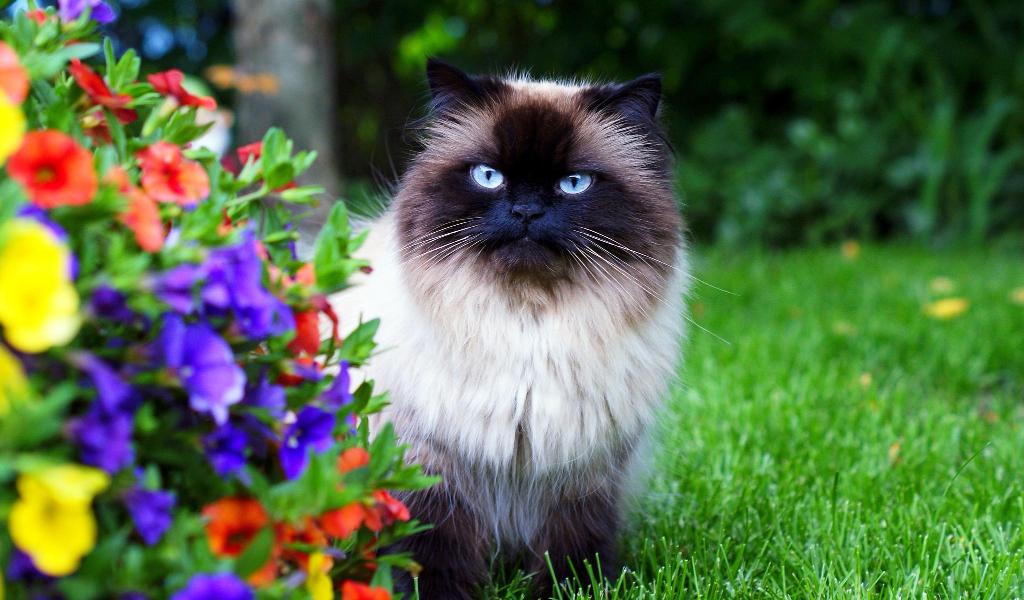
The Himalayan cat is a fluffy blue-eyed “ball” consisting of solid cosmic charm and universal good nature. Trouble-free in terms of behavior, moderately phlegmatic, but at the same time playful, Himalayas are the type of pets that you can get along with from the first minutes of acquaintance. You should not expect dizzying acrobatic stunts and zeal for learning from the Persian-Siamese. But they will willingly give the owner a “paw” massage or conduct a psychotherapeutic session based on soothing purring, sniffing and focused hypnotizing with a look.
History of the Himalayan cat breed
Oddly enough, the name of the breed is absolutely not related to the area of its breeding. In fact, the homeland of cats is the United States, and the definition of “Himalayan” stuck to them simply because their color coincided with the suit of rabbits living in the vicinity of the Himalayas. The first attempts to breed a Persian cat with a color-point color were made back in the 30s of the XX century at Harvard University. The experiment was successful, but the felinological associations were not impressed, so the animals did not receive the status of an independent breed then. But British breeders became interested in them, seizing the initiative from foreign colleagues and starting their experiments on crossing.
In the early 1950s, American breeders Virginia Cobb, Margarita Gorford and Clyde Keeler were once again promoting the new breed. As a result, in 1955, the Himalayan cats were recognized by the GCCF, and two years later by the CFA. It is worth noting that in the early stages, the breeders simply wanted to form an atypical Siamese color among the Persians , while retaining the rest of the external characteristics. As a result, the animals were bred mainly by the method of intrabreeding outbreeding. In the 60s, the fashion changed, and individuals born as a result of direct crossing of Persians with Siamese began to appear in nurseries , which introduced a strong dissonance into the ranks of the breeding stock.
Breeders managed to agree and come to a single standard only by the end of the 80s. As a result, they relied on the dominant “Persian” features of the exterior, which led to the designation of the breed in the CFA feline registries as Himalayan-Persian. As for the domestic Himalayas, their numbers are extremely small – color-pointed fluffies came to our country on the eve of the collapse of the USSR and did not cause a stir. To date, the popularity of Himalayan cats in the world has also slightly decreased, although in the second half of the 90s the breed literally “lit up” in the show rings.
Video: Himalayan cat
Himalayan cat breed standard
At first glance, the Himalayan is a typical Persian who decided to disguise himself as a Siamese . Blue eyes to animals also passed from representatives of the oriental group. Actually, the breed is most often identified by the color of the iris. The general fatness of the build, bordering on the average degree of obesity, is nothing more than an optical illusion created by the cat’s voluminous fur. Under his “fur coat”, the Himalaya hides quite average dimensions and a moderate stocky build.
Officially, the breed is bred in two lines. The first is the classic Persian type, whose representatives have delicate puppet “faces” with a short, but not too upturned nose. The second variety is the so-called Beijing (Pekingese) Himalayas, which have more flattened muzzles of a pronounced brachycephalic type. In recent years, there has been a tendency to extremization of the exterior characteristics of the family, therefore, cats with hyperbolized round eyes and snub noses most often fall into the show class.
Head
The head of the Himalayan cat is characterized by a flattened domed shape, an impressive width and a developed chin area. The size of the cranium is from large to medium. The cheeks are puffy-voluminous, the expression of the muzzle is touchingly tender.
Jaws
Representatives of the breed have fairly wide and powerful jaws. The bite should be correct, that is, of the pincer type, when the incisors are closed straight.
Ears
Himalayan cats have very tiny ears with a rounded tip. The distance between the organs of hearing is large, the set of the ears is low.
Eyes
The eyes are perfectly round, widely spaced, shaped like transparent buttons. The iris is clean, expressive, painted in a rich blue or pale blue tone. The look can be both focused and hypnotizing, and slightly bewildered.
Himalayan cat Nose
The correct Himalaya has a miniature snub-nosed and short nose. During sleep, the cat may snore and snore, which is considered an acceptable physiological feature for animals with a brachycephalic structure of the muzzle. An important requirement: the nose, forehead and chin are located in one straight line.
Neck
The neck of the Himalayan cat is always thick and short, but it is important that it is muscular and flexible.
Body
The Himalaya has a large (not to be confused with swollen) body with soft outlines. Shoulders and rump are equally voluminous. The backs of the representatives of the breed are of a shortened type, ideally even. The belly and ribs are moderately rounded. The muscular corset in Persian-Siamese is developed, but at the same time it is distinguished by amazing softness, which is easy to confuse with an excess of adipose tissue. The frame is strong and quite heavy.
Legs
When viewed from the front and back, the limbs look straight. The front legs are very short, which gives the cat a slight “toy-like” appearance.
Tail
The tail is of normal proportions, comparatively short and straight.
Wool
Himalayan cats have the richest “fur coats”, giving purrs a resemblance to giant pompoms. Elongated throughout the body, the soft coat is “reinforced” with elastic, dense layers of undercoat.
Color
An animal with a pure pedigree has a Siamese mask on its muzzle. It is also obligatory to have shaded marks on the tail, paws and ears. The colors of Himalayan cats registered by the standard are: blue point, lilac point, seal point (dark brown markings), chocolate point, as well as red-red and cream point.
Faults and disqualifying vices
Individuals with contrasting spots in the form of a medallion or buttons, as well as animals with any eye color other than blue, do not receive the championship title. Cats with kinks in the tail, asymmetrical muzzles, malocclusion (noticeable overshot or undershot bite) and strabismus are unconditionally disqualified.
Himalayan cat personality
By the nature of the Himalayas, they are more like imposing Persians than masterful Siamese , so that in everyday life these comrades behave neatly and peacefully. True, occasionally “inspiration” descends on the cat, and then the fluffy darling begins to trade in petty hooliganism. Therefore, often remember the episode from the comedy with Ben Stiller, where the Himalayan bespredelnik flushes the dog that bothered him into the toilet, and follow the changes in the mood of the ward.
Otherwise, Himalayan cats are quite sofa-cushion pets, dependent on comfort and affectionate atmosphere. These fluffy sybarites are happy to take a nap on the master’s knees and will be happy to accompany a person in his movements around the apartment. To some, such behavior will seem like a banal obsession, but in fact, animals thus satisfy the irrepressible curiosity received from Siamese ancestors. As an example: if the ward climbed onto the table where you laid out the working documents, do not rush to take his actions for shameless sabotage. It is likely that the cat just decided to help you with business.
Himalayans are much more playful than their Persian relatives , therefore, they can drive a lump of paper around the apartment or a feather that has flown through the window to exhaustion. If you give the purr a stuffed catnip mouse, the animal will fall into real euphoria. True, you should not expect that the fluffy gamer will rush at the speed of a meteor – such extreme activity is not characteristic of the breed. The toy object will be tortured with sense, with feeling, with arrangement and often at a half-asleep pace, occasionally interspersed with sharp attacks.
The Himalayan cat is very loving and feels sincere sympathy for all family members, provided that they reciprocate. At the same time, the pet will always have a separate pet, which will get a little more affection and contented rumbling than the rest of the household. Representatives of this fluffy family are not vindictive and not vindictive, but they subtly feel the mood of the one with whom they communicate. So if you are the same owner who believes that stroking a cat is only spoiling, you are not on the way with Persian-Siamese. Even in the most critical situations, Himalayan cats also prefer not to release their claws, sincerely counting on a peaceful resolution of the conflict.
Education and training
Despite the generally docile nature, Himalayan cats are in no hurry to join the educational process. For this reason, it is necessary to instill the basic norms of etiquette in an animal from a very early age – an adult Persian-Siamese who has managed to master bad habits, alas, cannot be re-educated. After the kitten has socialized and got used to the new home, immediately engage in the formation of his toilet habit. The tray should be located in the most calm and quiet place and in no case next to the food bowl.
You need to plant a small Himalayan on a tray immediately after sleep and active games. In order for the baby to understand that the toilet belongs only to him, it is recommended to put a piece of cloth in the filler, with which you previously wiped the puddle left by the pet. Along the way, wean the animal from the habit of sharpening its claws on furniture, but first buy a scratching post. If after that the kitten encroaches on the upholstery, sprinkle water on it when you find it sabotaging, and then send it back to the scratching post.
Are you used to leaving fragrant delicacies on the table? Get ready for the cat to taste them! The Himalayans, of course, are passive comrades, but they will not resist a tasty treat left unattended. It is necessary to wean the ward from jumping on the table immediately and unconditionally. First, do not leave meat products on the kitchen surface so as not to tempt the fluffy. Secondly, try to make this piece of furniture evoke unpleasant associations in the animal. For example, treat it with a strong menthol or citrus scent that cats hate. You can also spread scotch tapes on the table with the sticky side up to “catch” the prankster with them.
Teaching a Himalayan cat funny tricks is difficult and essentially unnecessary, but if you decide to play the great trainer, stock up on deli meats. Make allowances for the fact that cats are not dogs; they will not strain solely out of a desire to please you. An important nuance is to clearly convey to the animal what is expected of it. For example, if you want to teach a cat to sit down on command, then you first need to demonstrate a treat, and then gently incline the fluffy to the required position, encouraging him to perform the delicacy. Some owners use catnip as a training stimulus. This is the easiest way, which experts do not recommend to go.
It is also useful to slightly refine the method with a tasty reward by adding a clicker to the treat. Click the device while the command is being processed, and then, if the task is completed, please the cat with a treat. Soon the furry will understand that the sound of the clicker is followed by encouragement, and will comply with the requirements more willingly. By the way, if you notice that the cat is sincerely resisting your commands and trying to leave, you should not try to suppress his will. Do it only when the cat is ready to study and no more than once a day – in a 15-minute lesson, the breed exhausts its internal resource and needs a long rest.
Himalayan cat Maintenance and care
Himalayan cats are comfort-dependent creatures, so choose a comfortable bed, tray, toys, and bowls for food and drink responsibly. For hair care, it is better to invest in a set of combs, which must include a slicker comb, metal combs with frequent and rare teeth, and a natural bristle brush.
Dressed in voluminous “coats”, Perso-Himalayas are sensitive to temperature rise and in hot weather they easily get heat stroke. Animals also overheat in stuffy city apartments, so in the summer the cat will either have to be cut or turn on the air conditioner more often. The breed does not suffer from increased jumping ability. This means that you can save money on buying a high gaming complex or replace it with some interesting labyrinth with jute scratching posts.
Hygiene and hair care
Spectacular hair of Himalayan cats without care instantly loses its gloss, turning into a terrible collection of tangles and dirty “dreadlocks”. So three times a week, and during the shedding season – daily, get an arsenal of combs and work on your pet’s coat. First, the hair is “disassembled” with a rare comb, then the tangles are manually unraveled, removing the dead undercoat with the help of a furminator and a fine comb. The final touch is glossing with a natural bristle brush.
With an acute shortage of time, the animal can be sheared, but this number will not work with show individuals, who, after such transformations, simply will not be allowed to the exhibition. You should not rely on the fact that the cat will lick its fur on its own – even a gigantic tongue cannot cope with such a mop of hair as in the Himalayas. By the way, about licking: a remedy for removing wool from the stomach should always be in the first aid kit of the owner of a fluffy cat. Otherwise, get ready to spend a lot more on surgery at the vet.
Once a month, the Himalayan Perso is supposed to be bathed using a mild shampoo and conditioner – most animals are loyal to this procedure and do not panic. Drying wool with a hair dryer is allowed, but the fluffy will have to be accustomed to such manipulations gradually – the sound of a running hair dryer frightens and unnerves the kittens. Pay special attention to the hair around the anus – it needs to be trimmed periodically and washed thoroughly. The eyes of the representatives of the breed, due to the anatomical features, are leaking, therefore, their hygiene must be carried out daily. For this purpose, it is better to buy a special herbal lotion with taurine and D-panthenol. During the day, it is also useful to wipe the lacrimal grooves with a clean cloth soaked in chilled boiled water.
Himalayan cat ears are cleaned weekly with hygienic drops and cloth or cotton pads. Once every two or three days, it is advisable for a pet to brush its teeth, for which it is necessary to buy cat paste and a brush. Even if the fluffy ward has perfectly mastered the art of scratching the scratching posts, it is better for him to shorten his claws once a month – it is safer and more hygienic for furniture upholstery.
Himalayan cat Feeding
Himalayan kittens under the age of 6 months are fed 4 times a day. The same diet in adult pregnant cats. Six-month-old pets are transferred to a three-time diet, which is followed until the animal is 1.5 years old. Further, the Himalayan cat eats twice a day. If you do not want to deal with calculating the calorie content of each serving and spend time looking for useful vitamins and supplements, use dry and wet industrial feeds. At the same time, the “drying” class should not be lower than super-premium or holistic.
Feeding the Persian-Siamese with “natural” is also acceptable, but in a particular case it is easy to overdo it, since the breed is prone to overeating and weight gain. Products that a pet needs on a natural menu: lean meat, fish fillet (once a week or less), low-fat dairy products, vegetables (carrots, pumpkin), quail egg. Porridges as such are not required, although almost all breeders add rice and buckwheat to the meat to enrich the Himalaya’s daily diet with fiber. And of course, do not forget that it will not work to balance a cat’s home diet without ready-made vitamins and trace elements, so periodically look at the veterinary pharmacy and consult a veterinarian.
Health and disease of Himalayan cats
With good care and qualified medical support, the Himalayan cat lives up to 14-16 years. The health of the breed is not bad, there are no problems with immunity, while it is important to remember a number of physiological nuances. This, for example, difficulty in breathing is a frequent occurrence for all animals with a brachycephalic structure of the muzzle. In addition, the breed often has uncontrolled lacrimation. Another scourge of the Himalayas is obesity, aggravated by reduced physical activity, so the issue of nutrition will have to be given maximum attention.
Of the genetically determined diseases in the breed, polycystic kidney disease was detected. Also in animals, hyperesthesia syndrome, eye diseases (glaucoma, entropy, retinal atrophy), von Willebrand disease, urolithiasis, hypertrophic cardiomyopathy can occur. Predisposition to fungal infections, dermatosparaxis and primary seborrhea is manifested in a limited number of individuals.
How to choose a kitten
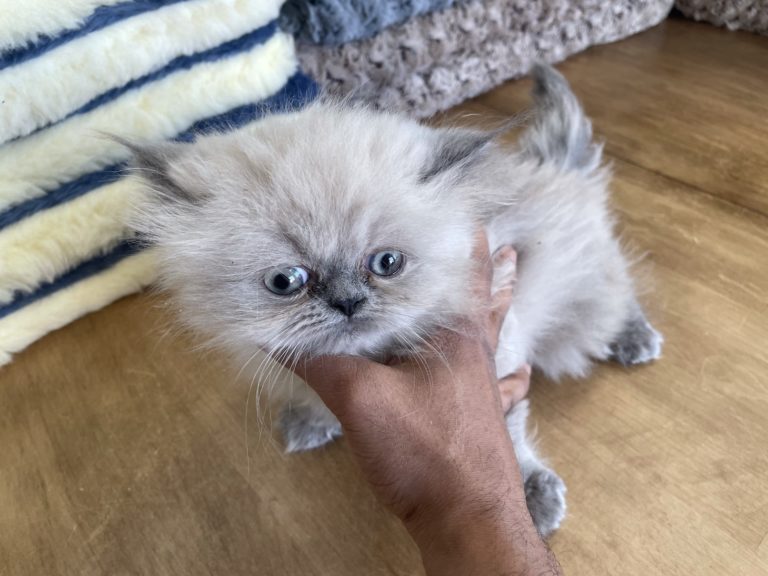

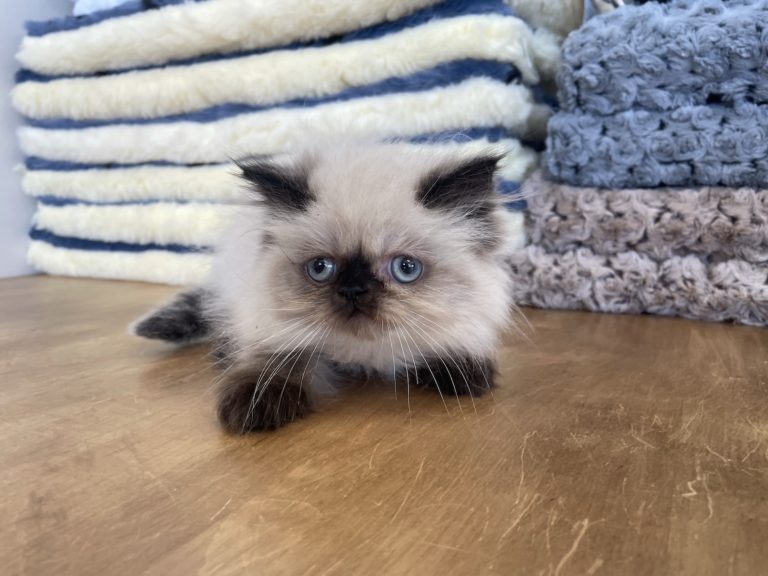

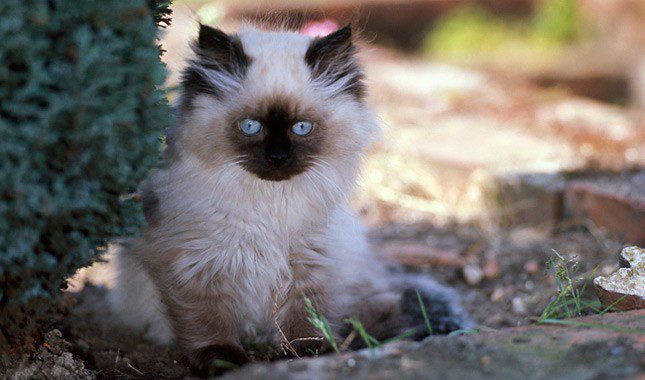

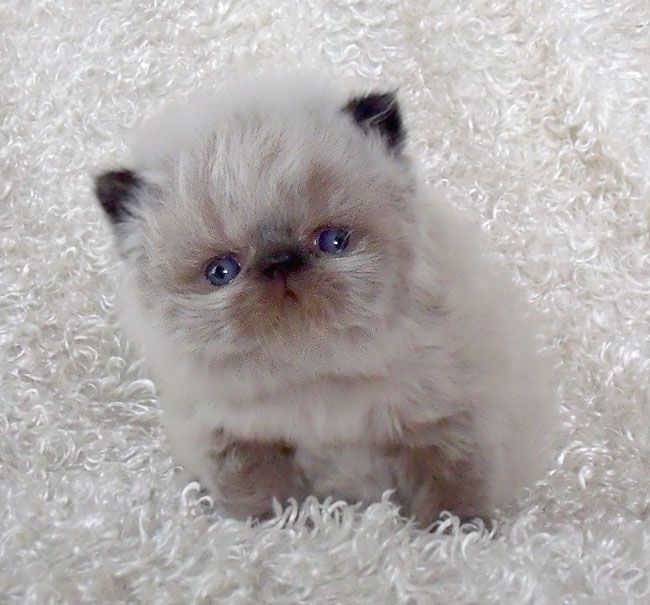

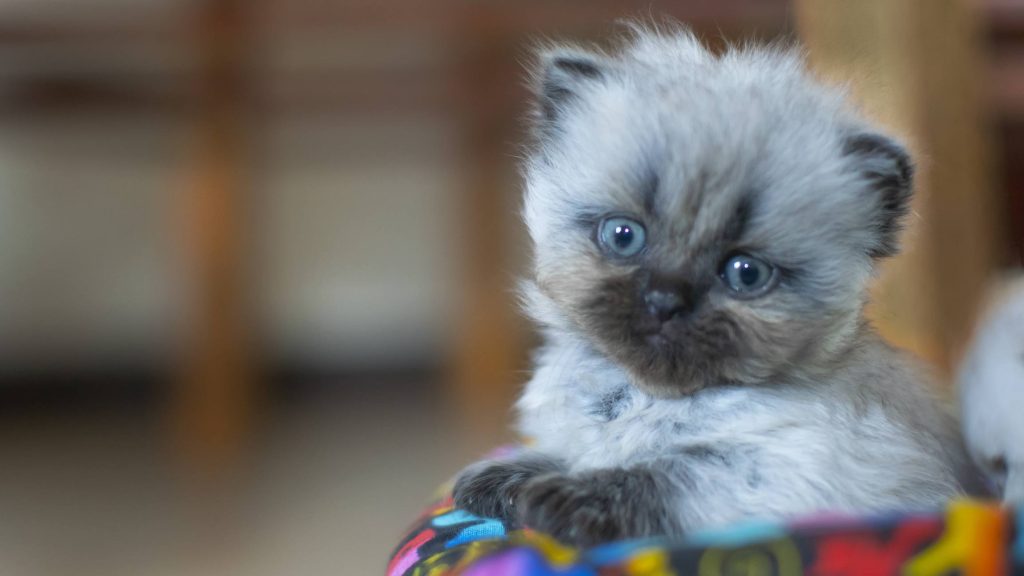

- Chocolate- and lilac-pointed Himalayan cats are born extremely rarely, so get ready to pay an order of magnitude more expensive for the owner of such a suit.
- The most common type of breed color is the seal point, which is also the least valued. Accordingly, if you want to save a little, choose an animal with such a “fur coat”.
- Himalayan kittens are born very light, often without a mask on the muzzle and with unpainted ears. The pigment on the head, paws, ears and muzzle is formed gradually and completely stabilized only in one and a half year old cats.
- Buy a pet from a seller who is willing to provide a cat metric with vaccination marks, as well as a health certificate for the animal.
- Before buying, visit the cattery several times to see what conditions the cat family lives in, what they are fed and how the babies are treated.
- Find out how many births a Himalayan cat has had in the past 12 months. Remember that felinological associations allow you to register no more than two litters per year. The best option is if the interval between the previous and last births is at least 8 months.
- Try to get reliable information about the age of the producers. In catteries registered by felinological systems, cats are taken out of breeding upon reaching the age of 5.
Himalayan cat price
A club Himalayan kitten with a good pedigree and no exterior defects costs around 400 – 500$. The price for show individuals of rare colors usually increases one and a half to two times and reaches 900 – 1000$. If you want to buy an animal cheaper, make a choice in favor of representatives of the pet class and kittens with defects in appearance that do not affect health. The average cost of such Himalayans is 150 – 200$. It is recommended to pay attention to the fact that in local nurseries they prefer to breed the Beijing type of breed, so in most cases get ready to get a brachycephalic pet.





